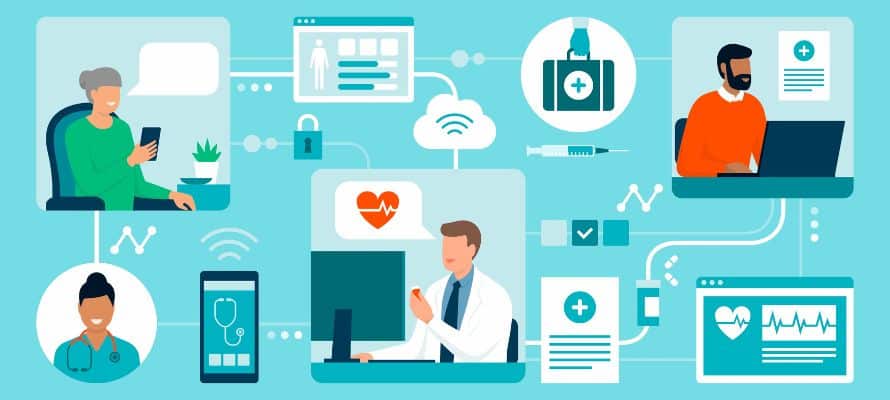
When we talk about communication strategies in healthcare, people often focus on how health systems communicate with patients. While patient communications are critical, employee relations in healthcare are reaching a breaking point. Retention is down. Financial strains are up. More healthcare workers are striking. Healthcare companies need their employee communication efforts to step up.
Clear and effective employee communication is no longer just an HR function—it’s a critical operational strategy in healthcare.
Trust matters: Employees trust their employers twice as much as governments when it comes to receiving health-related guidance.
Source: TIME
ROI is proven: Every $1 invested in wellness communication returns $3.27 through reduced healthcare costs and fewer sick days.
Source: TIME
Patient outcomes depend on it: Studies show strong internal communication directly improves patient satisfaction scores and reduces errors.
Healthcare communication strategies are a set of deliberate and coordinated efforts to share information and resources with their target audiences: healthcare professionals, administrative staff, patients, and other stakeholders within their health system.
Having a strong communication strategy is critical to ensuring that employees are supported in doing their jobs and providing excellent patient care.
This includes strategies for:
Although healthcare systems have to also communicate with patients and stakeholders, at theEMPLOYEEapp, we’re experts in employee communication. So, we’re going to focus on the top challenges healthcare companies face communicating internally.
The COVID-19 pandemic led to extreme pressures being put on healthcare employees. And it hasn’t really let up.
Information overload and staffing shortages are leading to employees feeling burnt out. And this isn’t just impacting your nurses and residents. Burnout trouble is even hitting the executive suite of health systems.
This means it’s harder than ever to break through the noise and get the attention of your healthcare teams. Our communications have to be efficient, targeted, and meaningful. If they aren’t, we risk adding to the noise and increasing the strain on our already stressed and overworked employees.
Healthcare systems employ a diverse workforce that includes clinicians, administrative staff, support personnel, and often contract workers.
Each group has its own communication needs and preferences.
For instance, clinical staff may require real-time updates on patient conditions, while administrative staff may need information on administrative processes and policies.
Effective communication must cater to this diversity, ensuring that all employees receive relevant and timely information for their role.
Technology advancements could revolutionize the healthcare industry. Not evolving with modern tools can spell disaster.
While there is a multitude of tools and technologies available for improving medicine itself, there’s also a communications technology evolution that you might be missing out on.
How you communicate and connect with employees needs to keep up with modern technology and employee expectations. In our daily lives, we’re all used to having technology work for us. It’s easy. Streamlined. And accessible 24/7.
But so often, we rely on outdated internal comms tools. We need to ensure our internal comms channels and strategies are keeping up.
So, how do we update our internal communication strategies to more effectively reach our healthcare staff?
Like we mentioned, it’s important to keep your communication tech stack up to date so you can implement your internal communication plans.
That might mean it’s time to audit your existing communication channels to find where your weaknesses are.
It might also be time to improve your mobile-first communication channels. Or to consider an intranet overhaul.
And it might mean investing in employee survey tools, video creation software, or other technologies that help bring your strategy to life.
Healthcare organizations are navigating rapid changes in technology, workforce diversity, and patient expectations. In 2025, internal communication strategies must adapt to these shifts to maintain safety, trust, and efficiency.
Artificial Intelligence is transforming healthcare communications by delivering role-specific, context-aware messaging that ensures staff get exactly what they need, when they need it.
Smart filtering reduces message overload, showing only the most relevant alerts to each employee’s department, shift, and patient load.
Predictive communication uses AI to anticipate staffing shortages, patient surges, or supply needs and proactively alerts the right teams.
Human oversight ensures that technology enhances empathy rather than replacing it—crucial in emotionally sensitive environments.
Source: Poppulo
Example: A hospital’s AI communication system detected increased ER traffic and sent early notifications to on-call staff, reducing wait times by 25%.
Modern healthcare teams are as diverse as the communities they serve—meaning internal communication must be accessible, culturally relevant, and inclusive.
Provide translated materials for critical updates in the top 3–5 languages spoken by staff.
Use inclusive imagery and examples in training materials to reflect different backgrounds, abilities, and experiences.
Consider accessibility compliance—caption all videos, use high-contrast visuals, and offer alternative text for digital content.
Competitive Insight: Top-ranking hospitals now tie internal inclusivity efforts to their patient satisfaction goals, ensuring staff feel respected and informed.
Example: A multilingual mobile app reduced miscommunication among a multicultural nursing team, improving patient discharge accuracy by 18%.
Communication is no longer a one-way broadcast—real-time employee feedback systems are becoming standard in leading healthcare organizations.
Pulse surveys after high-stress events (e.g., critical patient care or emergency drills) identify process gaps immediately.
Live polls during huddles or town halls give leaders instant insight into staff concerns and engagement.
Anonymous reporting channels encourage honest feedback without fear of reprisal, boosting psychological safety.
Source: Cerkl, Poppulo
Example: After introducing 2-minute weekly feedback check-ins, a hospital chain reduced staff turnover in high-burnout units by 14% in one year.
[optin-monster slug=”gqorn0natkqgyrtjvr6i” followrules=”true”]